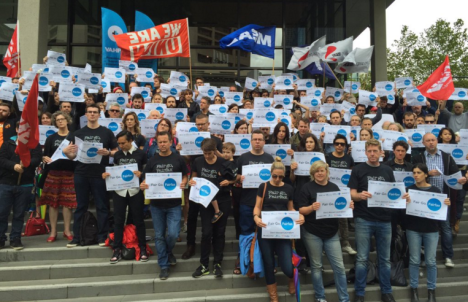Journalists’ union accuses Fairfax management of having a 20th Century print mentality
The union representing journalists the Media Entertainment and Arts Alliance (MEAA) has fired back at Fairfax management’s claim that the quantity of output is unrelated to the quality of journalism produced.

Fairfax staff protesting outside The Age two weeks ago.
Members of the MEAA house committee at the Sydney Morning Herald and The Age have penned a response to a opinion piece, published last Friday, by Fairfax CEO Greg Hywood that responded to critics who argue further proposed cuts at the publisher will mean lower quality publications, saying: “since when has quantity got to do with quality?”.
In a fiery response, the MEAA letter begins with: “You’re right, Greg. We do need to have a conversation about quality. However, it’s important that we’re not only on the same page, but in the same century.”


In today’s episode of Fairfax Journos vs The World, the MEAA unionsplains the history of journalism while failing to realise that their ‘quality journalism’ doesn’t pay the bills any longer.
“What worked 40 years ago doesn’t work today”
So ironic coming from a union.
Upvote for Trevor. Mind you, it I had to choose between the MEAA and Fairfax management as an example of forward thinking, I’m not sure I’d be able to decide.
Rather than let the print edition die a slow, inevitable death, why don’t they just stop producing it altogether and concentrate solely on the digital version, including Domain?
I loved 1976. Back then the SMH has news – not bias.
Hywood should let his hair down. His favourite recollection of 1976 is of spending the whole of his first day employed at Fairfax in a nearby pub. His sole digital anecdote involves visiting “Silicon Valley” once. And now he is up against a union led by Marcus Strom, who he allows to be news editor of the SMH and who is an avowed Marxist while a Stalinist pedigree (no kidding, this is fact).
This Fairfax debacle is becoming hard to watch.
As a digital subscriber I must say it feels like the content on smh has steadily gone down hill in the last few months. Having moved to Hong Kong, I kept my smh digital sub hoping to check in for relevant commentary, analysis and discourse on the nation. Instead I’m seemingly served up pr surveys, headlines with no underlying content of meaning, or simply crap I have no interest in reading.
Maybe my tastes have changed, maybe the product has eroded. I suspect the later.
All those thinking the union is stuck in the past are not up-to-date in their thinking.
Stephen, because it’s all about advertising revenue. A digital-only media operation usually doesn’t survive for long because the ad revenues are a fraction of what they are for print. Go down that road and you better have “robots” (ie algorithims) replace all humans in the newsroom.
@fading sub.
you understand the concept of costs, and how they effect profit margins, right?
@CCAW
“And now he is up against a union led by Marcus Strom, who he allows to be news editor of the SMH and who is an avowed Marxist while a Stalinist pedigree”
I gather you dont then assume that there will be a Marxist edge to the news. Marxists are usually middle-class and fall back on conditioned upbringing once they hit middle-age. I’m an ex-Marxist (I guess) and most ex Marxists are very comfy in middle-class lifestyle. Not so revolutionary in the end when it matters (owning property, needing a career, nice friends etc). A good Cosplay when you are rebellious against your Roseville parents and their tennis club (err I meant Rooty Hill of course, workers and such…)
If he has a Stalinist background, my guess would be that he was a member of the Socialist Party of Australia (SPA/Guardian Newspaper (no not THAT Guardian), the only Stalinist followers of the lot in the 80s/90s (DSP/Resistance, ISO, Sparticists, remnants of the CPA). TMI I am sure, but you started it! 🙂
@Hank
Of course I do but what I don’t understand is how executives can give themselves bonus pay rises even as they cite “cost efficiencies” as to A) why they were letting staff go and B) why staff couldn’t even get a pay rise that matched cost on inflation despite the fact that the pay rise they sought was still not as much as the executives’ pay rise.
@fading sub
Yes I do understand it’s all about ad revenue – my point is that they aren’t generating enough of it. The first 30 pages of today’s SMH – before you get to the “rivers of gold” classifieds that run a total of less than 3 pages – contain 2 x full page ads, 2 x 1/4 page ads, and a 1/2 page ad. So 5 display ads in total. Those 5 ads and a pittance in classifieds couldn’t possibly cover the costs of producing today’s paper